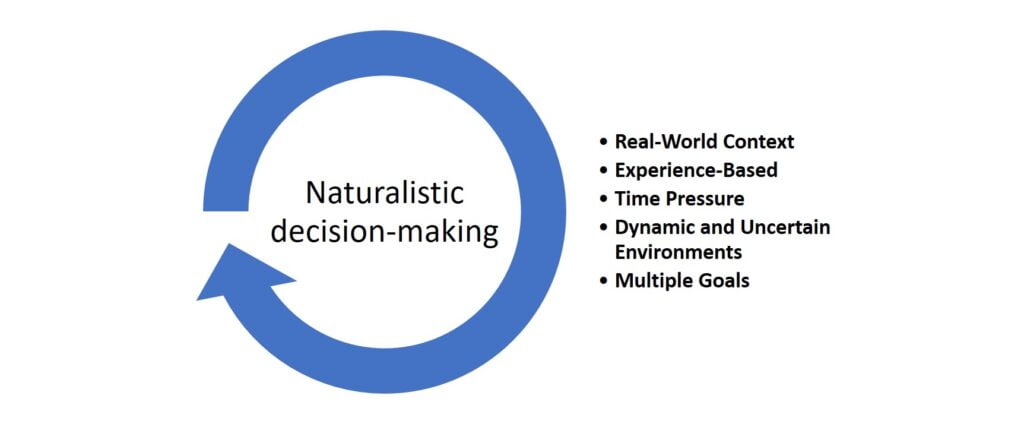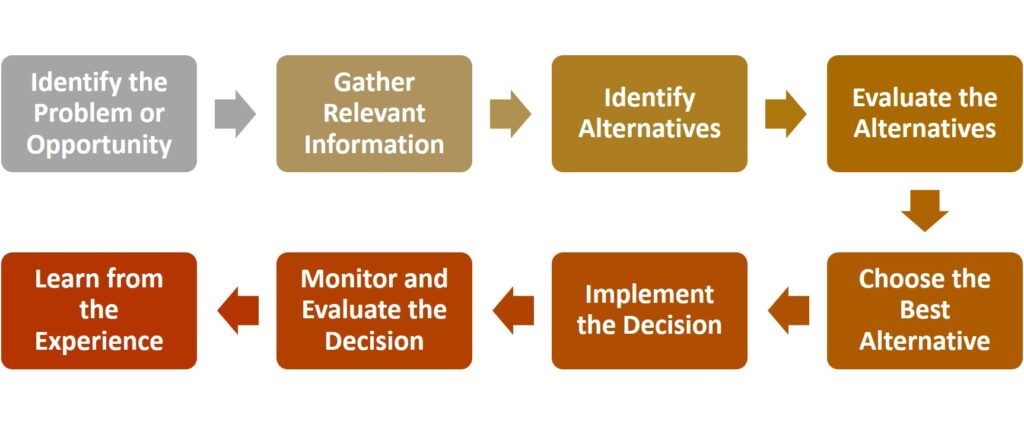Decision-making is the art of selecting a course of action from multiple options to get the intended result. Decision-making ranges from choosing the dinner menu to determining the strategic direction of a corporation. It involves understanding situations, collecting necessary information, verifying options, and selecting the right thing.
Types of decision-making
There are various types of decision-making including strategic, managerial, collaborative, intuitive, and rational.

Strategic Decision-Making
It involves long-term planning that aligns with the company’s vision, considering nearer and distant implications, and choosing the best alternative. It requires a complete analysis of internal and external environments. Strategic decisions are critical for the sustained success of an organization. Imagine an automotive firm is experiencing a decline in sales and reducing manpower. To counter this problem, management examines the market trends, aligns with cutting-edge technologies, and provides training to the staff. This strategic decision sets the stage for continued growth and sustainability.
If you are interested in learning about cutting-edge technologies, refer to the top trends in Industry 4.0 that will rule the world.
Managerial Decision-Making
It focuses on the effective and efficient use of resources to achieve business goals. Managerial decisions may take various forms including investing, financing, training, implementing policies and programs, etc. To make sound decisions, managers must balance multiple factors, such as cost, quality, and time.
Collaborative Decision Making
This process requires multiple stakeholders to work together to reach an agreement. This approach leverages diverse perspectives and expertise, leading to more extensive and inclusive decisions.
Consider a product design team in charge of making a new product. Each member shares their thoughts or opinions during team meetings. They collaborate on ideas, discuss solutions, and innovate. These decisions are well supported by their managers.

Intuitive Decision Making
It is a process where decisions are made based on instincts, gut feelings, or inner judgments rather than through deliberate analysis or reasoning. This type of decision-making often draws on experience, past knowledge, and subconscious information processing.
Imagine a firefighter in the middle of a burning building. Suddenly, they sense that the structure is about to collapse without seeing any obvious signs. The firefighter instinctively orders everyone out of the building immediately instead of stopping to analyze all the data.
In this scenario, the firefighter’s experience and knowledge allowed them to subconsciously pick up on subtle cues (like the intensity of the fire, temperature, or sounds) that led them to make a quick, life-saving decision. This is an example of intuitive decision-making at work.
It is useful in high-pressure situations where quick decisions are needed, and there isn’t enough time to analyze all the information. However, it can also be influenced by biases or limited experience, so it’s most effective when combined with experience and expertise.
Rational Decision Making
It is a structured approach based on logic, data, and systematically analyzing all available options. This approach involves clearly defining the problem, gathering relevant information, weighing the pros and cons of different alternatives, and selecting the option that maximizes benefits while minimizing risks.
A company is considering launching a new product. They have to do market research, competitor analysis, and estimate costs. They have to try each option and assess the risks. Then the team chooses the best alternative and proceeds.
Read more, Explore These 5 AI Trends in Business to Stay Competitive.
Consensus-Based Decision Making
It is a collaborative way where a group works together to reach a decision that everyone can agree on, or at least support. Unlike majority voting, where the option with the most votes wins, consensus seeks to find a solution acceptable to all participants. It focuses on collective agreement and the combination of diverse outlooks. For these decisions, everyone can express their opinions and may have to compromise their positions to reach a consensus.
Consider a small community group deciding on a place for conducting weekly meetings. Everyone expresses their thoughts according to their preferences. Through discussion, they reach a common ground and decide on one place. Everyone agrees provided that their accessibility or mobility issue is taken into account.
In this example, the decision-making process involved listening to everyone’s input, finding a solution aligning with different needs, and making compromises. The goal was to reach a decision that all participants could support. This method is often used in collaborative settings to ensure buy-in and commitment from all stakeholders.
Naturalistic Decision Making
It focuses on decisions in real-world, complex environments with limited time and high stakes. It emphasizes understanding decision-making in contexts where individuals rely on their experience, expertise, and situational awareness, rather than on systematic analysis or structured methods.

Key Characteristics
Real-World Context: NDM is used in settings such as emergency services, military operations, or healthcare.
Experience-Based: Decisions are heavily influenced by the decision-maker’s past experiences, allowing them to recognize patterns and apply previous knowledge to new situations.
Time Pressure: NDM often occurs in situations where there is little time for thorough analysis, requiring quick, yet effective, decision-making.
Dynamic and Uncertain Environments: The decision-making environment is often unpredictable with rapidly changing variables.
Multiple Goals: Decision-makers might need to balance conflicting goals or objectives simultaneously.
Learn more, How to Set and Track Smart Goals.
Step-by-step Decision-Making Process in a Company
Decision-making in a business or company involves a systematic process that helps ensure that choices are made thoughtfully, based on data, and aligned with the organization’s goals. Here’s a step-by-step guide to the decision-making process in a business context:

Identify the Problem or Opportunity
| Goal | Action |
| Clearly define what needs to be decided | Determine whether the situation is a problem that needs solving (e.g., declining sales) or an opportunity to capitalize on (e.g., a new market trend). |
Example: A company notices that its customer retention rate is decreasing. The problem identified is the need to improve customer retention.
It is crucial to select the right market to expand your business. Read our post on 9 ways to choose the right market for your business expansion to learn more.
Gather Relevant Information
| Goal | Action |
| Collect data and necessary information | Research internal and external sources, such as financial records, market trends, competitor analysis, and customer feedback. |
Example: The company gathers data on customer complaints, surveys, and sales records, and analyzes competitor strategies to understand why customers are leaving.
Identify Alternatives
| Goal | Action |
| Generate a list of possible solutions or actions to address the problem or opportunity. | Brainstorm with the team, consult experts, and explore different strategies. Consider all feasible options. |
Example: The company identifies several alternatives, such as enhancing customer service, launching a loyalty program, or improving product quality.
Evaluate the Alternatives
| Goal | Action |
| Assess the pros and cons of each alternative. | Analyze the potential results, costs, risks, and benefits. Use tools like SWOT analysis, cost-benefit analysis, or decision matrices. |
Example: The company evaluates the cost of implementing a loyalty program versus the expected increase in customer retention and long-term revenue.
Choose the Best Alternative
| Goal | Action |
| Select the option that offers the best balance of benefits and risks. | Make a decision based on the evaluation, considering both short-term and long-term impacts. |
Example: After evaluating the options, the company decides to implement a loyalty program, as it offers the best potential to retain customers and boost sales.
Implement the Decision
| Goal | Action |
| Put the chosen alternative into action. | Develop a detailed implementation plan, allocate resources, assign responsibilities, and set a timeline. |
Example: The company develops the loyalty program, trains staff, launches a marketing campaign, and rolls out the program to customers.
Monitor and Evaluate the Decision
| Goal | Action |
| Assess the effectiveness of the decision after implementation. | Track key performance indicators (KPIs), gather feedback, and measure the outcomes against the expected results. Be ready to make adjustments if necessary. |
Example: The company monitors customer retention rates, program participation, and sales figures to determine if the loyalty program is achieving its goals. They adjust the program based on customer feedback or changing market conditions.
Learn from the Experience
| Goal | Action |
| Reflect on the decision-making process and the outcome to improve future decisions. | Document lessons learned, analyze what worked well, and identify areas for improvement in the decision-making process. |
Example: The company reviews the entire process, noting what contributed to the successful implementation and what could be done better next time. This knowledge is shared across the organization to enhance future decision-making.
This structured approach helps businesses make informed, well-considered decisions that align with their strategic goals and objectives, ensuring that resources are effectively utilized and risks are managed.



